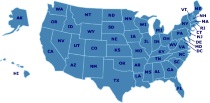Community Colleges
Many community colleges around the country have opened their doors to homeschooled teenagers, giving them an opportunity to start their college careers early, to gain classroom experience and college credit, to challenge them with more difficult materials, and to expand their horizons. Many parents look to community colleges to provide instruction in materials that they are not well suited to teach themselves.
Links
American Association of Community Colleges (AACC)
Founded in 1920, the American Association of Community Colleges (AACC) has, over four decades, become the leading proponent and the national “voice for community colleges.” Today, AACC’s membership represents close to 95 percent of all accredited U.S. two-year community, junior and technical colleges and their 10.5 million students, as well as a growing number of international members in Puerto Rico, Japan, Great Britain, Korea, and the United Arab Emirates. The colleges are the largest and fastest-growing sector of U.S. higher education, enrolling close to half (45 percent) of all U.S. undergraduates. AACC supports and promotes its member colleges through policy initiatives, innovative programs, research and information and strategic outreach to business and industry and the national news media.
And What About College?: How Homeschooling Can Lead to Admissions to the Best Colleges & Universities
Get all your questions about helping your homeschooled student apply and get accepted to college answered with this resource. It discusses transcripts, diplomas, education choices, online colleges, and more. If you are worried about whether your homeschooled student can have a successful college search, then this book will help allay those fears and offers good support and information.
Featured Resources
As an Amazon Associate, we earn from qualifying purchases. We get commissions for purchases made through links on this site.
The Case for Classical Christian Education
Douglas Wilson looks at the state of America's school system and offers a remedy for those who are committed to their children's best interests in education. Wilson details the history of the classical education movement and discusses what is needed for a useful curriculum. Readers will come to understand that classical education offers the best opportunity for academic achievement, character growth, and spiritual education.
The Grammar Of Our Civility: Classical Education In America
This book explains the history of classical education in America and offers a vision for the role of classical education in 21st century America.
Habits: The Mother's Secret to Success (Charlotte Mason Topics - Volume 1)
This work contains a selection of the writings of Charlotte Mason, a British educator. Her writings from the 1880s are still relevant today and contain ideas that can be easily and successfully incorporated into homeschooling. This book focuses on the concept of building good habits in children, why it is important, how it can be implemented, and what impact it will make on home life and homeschooling. Written from a mother's point of view, Mason's works and ideas are explained and distilled int...
A Reason For® Handwriting
A Reason For® Handwriting provides a fun, meaningful approach to developing effective handwriting skills. Each lesson is built around a Scripture verse chosen not only for proper letter combinations, but also inspirational content. “Border Sheets” encourage students to share God's Word with others. You'll find product information about A Reason For® Handwriting here.
Organizing Plain and Simple: A Ready Reference Guide With Hundreds Of Solutions to Your Everyday Clutter Challenges
Desk drowning in papers? No room for the car in the garage? Santa still sitting on the roof in May? A less-is-more philosophy is great, but we all still have way too much stuff. The home office swallows up whole rooms, as does the family computer station. Then there's the home gym, the TV room, and the playroom, not to mention our collections - books, CDs, toys. Time management experts agree that when the minor things that take up space in the mind are eliminated, there is room to think about th...





